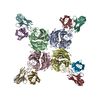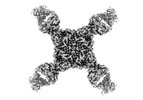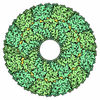[English] 日本語
 Yorodumi
Yorodumi- EMDB-41824: A mechanistic understanding of protective influenza B neuraminida... -
+ Open data
Open data
- Basic information
Basic information
| Entry |  | |||||||||
|---|---|---|---|---|---|---|---|---|---|---|
| Title | A mechanistic understanding of protective influenza B neuraminidase mAbs at the airway interface | |||||||||
 Map data Map data | ||||||||||
 Sample Sample |
| |||||||||
 Keywords Keywords | Neuraminidase Sialidase / HYDROLASE | |||||||||
| Function / homology |  Function and homology information Function and homology informationexo-alpha-sialidase / exo-alpha-sialidase activity / carbohydrate metabolic process / host cell plasma membrane / virion membrane / metal ion binding / membrane Similarity search - Function | |||||||||
| Biological species |  Homo sapiens (human) / Homo sapiens (human) /  Influenza B virus (B/Iowa/06/2017) Influenza B virus (B/Iowa/06/2017) | |||||||||
| Method | single particle reconstruction / cryo EM / Resolution: 3.36 Å | |||||||||
 Authors Authors | Ferguson JA / Oeverdieck S / Ward AB | |||||||||
| Funding support |  United States, 1 items United States, 1 items
| |||||||||
 Citation Citation |  Journal: Immunity / Year: 2024 Journal: Immunity / Year: 2024Title: Isolation of human antibodies against influenza B neuraminidase and mechanisms of protection at the airway interface. Authors: Rachael M Wolters / James A Ferguson / Ivette A Nuñez / Elaine E Chen / Ty Sornberger / Luke Myers / Svearike Oeverdieck / Sai Sundar Rajan Raghavan / Chandrahaas Kona / Laura S Handal / ...Authors: Rachael M Wolters / James A Ferguson / Ivette A Nuñez / Elaine E Chen / Ty Sornberger / Luke Myers / Svearike Oeverdieck / Sai Sundar Rajan Raghavan / Chandrahaas Kona / Laura S Handal / Trevor E Esilu / Edgar Davidson / Benjamin J Doranz / Taylor B Engdahl / Nurgun Kose / Lauren E Williamson / C Buddy Creech / Katherine N Gibson-Corley / Andrew B Ward / James E Crowe /  Abstract: Influenza B viruses (IBVs) comprise a substantial portion of the circulating seasonal human influenza viruses. Here, we describe the isolation of human monoclonal antibodies (mAbs) that recognized ...Influenza B viruses (IBVs) comprise a substantial portion of the circulating seasonal human influenza viruses. Here, we describe the isolation of human monoclonal antibodies (mAbs) that recognized the IBV neuraminidase (NA) glycoprotein from an individual following seasonal vaccination. Competition-binding experiments suggested the antibodies recognized two major antigenic sites. One group, which included mAb FluB-393, broadly inhibited IBV NA sialidase activity, protected prophylactically in vivo, and bound to the lateral corner of NA. The second group contained an active site mAb, FluB-400, that broadly inhibited IBV NA sialidase activity and virus replication in vitro in primary human respiratory epithelial cell cultures and protected against IBV in vivo when administered systemically or intranasally. Overall, the findings described here shape our mechanistic understanding of the human immune response to the IBV NA glycoprotein through the demonstration of two mAb delivery routes for protection against IBV and the identification of potential IBV therapeutic candidates. | |||||||||
| History |
|
- Structure visualization
Structure visualization
| Supplemental images |
|---|
- Downloads & links
Downloads & links
-EMDB archive
| Map data |  emd_41824.map.gz emd_41824.map.gz | 118.1 MB |  EMDB map data format EMDB map data format | |
|---|---|---|---|---|
| Header (meta data) |  emd-41824-v30.xml emd-41824-v30.xml emd-41824.xml emd-41824.xml | 22 KB 22 KB | Display Display |  EMDB header EMDB header |
| Images |  emd_41824.png emd_41824.png | 63.8 KB | ||
| Filedesc metadata |  emd-41824.cif.gz emd-41824.cif.gz | 7.1 KB | ||
| Others |  emd_41824_half_map_1.map.gz emd_41824_half_map_1.map.gz emd_41824_half_map_2.map.gz emd_41824_half_map_2.map.gz | 115.9 MB 115.9 MB | ||
| Archive directory |  http://ftp.pdbj.org/pub/emdb/structures/EMD-41824 http://ftp.pdbj.org/pub/emdb/structures/EMD-41824 ftp://ftp.pdbj.org/pub/emdb/structures/EMD-41824 ftp://ftp.pdbj.org/pub/emdb/structures/EMD-41824 | HTTPS FTP |
-Validation report
| Summary document |  emd_41824_validation.pdf.gz emd_41824_validation.pdf.gz | 811.6 KB | Display |  EMDB validaton report EMDB validaton report |
|---|---|---|---|---|
| Full document |  emd_41824_full_validation.pdf.gz emd_41824_full_validation.pdf.gz | 811.2 KB | Display | |
| Data in XML |  emd_41824_validation.xml.gz emd_41824_validation.xml.gz | 14 KB | Display | |
| Data in CIF |  emd_41824_validation.cif.gz emd_41824_validation.cif.gz | 16.6 KB | Display | |
| Arichive directory |  https://ftp.pdbj.org/pub/emdb/validation_reports/EMD-41824 https://ftp.pdbj.org/pub/emdb/validation_reports/EMD-41824 ftp://ftp.pdbj.org/pub/emdb/validation_reports/EMD-41824 ftp://ftp.pdbj.org/pub/emdb/validation_reports/EMD-41824 | HTTPS FTP |
-Related structure data
| Related structure data |  8u1qMC  8u1cC  8u1sC M: atomic model generated by this map C: citing same article ( |
|---|---|
| Similar structure data | Similarity search - Function & homology  F&H Search F&H Search |
- Links
Links
| EMDB pages |  EMDB (EBI/PDBe) / EMDB (EBI/PDBe) /  EMDataResource EMDataResource |
|---|---|
| Related items in Molecule of the Month |
- Map
Map
| File |  Download / File: emd_41824.map.gz / Format: CCP4 / Size: 125 MB / Type: IMAGE STORED AS FLOATING POINT NUMBER (4 BYTES) Download / File: emd_41824.map.gz / Format: CCP4 / Size: 125 MB / Type: IMAGE STORED AS FLOATING POINT NUMBER (4 BYTES) | ||||||||||||||||||||||||||||||||||||
|---|---|---|---|---|---|---|---|---|---|---|---|---|---|---|---|---|---|---|---|---|---|---|---|---|---|---|---|---|---|---|---|---|---|---|---|---|---|
| Projections & slices | Image control
Images are generated by Spider. | ||||||||||||||||||||||||||||||||||||
| Voxel size | X=Y=Z: 1.15 Å | ||||||||||||||||||||||||||||||||||||
| Density |
| ||||||||||||||||||||||||||||||||||||
| Symmetry | Space group: 1 | ||||||||||||||||||||||||||||||||||||
| Details | EMDB XML:
|
-Supplemental data
-Half map: #1
| File | emd_41824_half_map_1.map | ||||||||||||
|---|---|---|---|---|---|---|---|---|---|---|---|---|---|
| Projections & Slices |
| ||||||||||||
| Density Histograms |
-Half map: #2
| File | emd_41824_half_map_2.map | ||||||||||||
|---|---|---|---|---|---|---|---|---|---|---|---|---|---|
| Projections & Slices |
| ||||||||||||
| Density Histograms |
- Sample components
Sample components
-Entire : Complex of human mAb-fv domain bound to influenza B neuraminidase...
| Entire | Name: Complex of human mAb-fv domain bound to influenza B neuraminidase, from a public database. |
|---|---|
| Components |
|
-Supramolecule #1: Complex of human mAb-fv domain bound to influenza B neuraminidase...
| Supramolecule | Name: Complex of human mAb-fv domain bound to influenza B neuraminidase, from a public database. type: complex / ID: 1 / Parent: 0 / Macromolecule list: all |
|---|---|
| Source (natural) | Organism:  Homo sapiens (human) Homo sapiens (human) |
-Macromolecule #1: Neuraminidase
| Macromolecule | Name: Neuraminidase / type: protein_or_peptide / ID: 1 / Number of copies: 1 / Enantiomer: LEVO |
|---|---|
| Source (natural) | Organism:  Influenza B virus (B/Iowa/06/2017) Influenza B virus (B/Iowa/06/2017) |
| Molecular weight | Theoretical: 51.104258 KDa |
| Recombinant expression | Organism:  |
| Sequence | String: MLPSTIQTLT LFLTSGGVLL SLYVSASLSY LLYSDILLKF SPTEITAPTM PLDCANASNV QAVNRSATKG VTLLLPGPEW TYPRLSCPG STFQKALLIS PHRFGETKGN SAPLIIREPF VACGPNECKH FALTHYAAQP GGYYNGTRGD RNKLRHLISV K LGKIPTVE ...String: MLPSTIQTLT LFLTSGGVLL SLYVSASLSY LLYSDILLKF SPTEITAPTM PLDCANASNV QAVNRSATKG VTLLLPGPEW TYPRLSCPG STFQKALLIS PHRFGETKGN SAPLIIREPF VACGPNECKH FALTHYAAQP GGYYNGTRGD RNKLRHLISV K LGKIPTVE NSIFHMAAWS GSACHDGKEW TYIGVDGPDN NALLKVKYGE AYTDTYHSYA NNILRTQESA CNCIGGNCYL MI TDGSASG VSECRFLKIR EGRIIKEIFP TGRVKHTEEC TCGFASNKTI ECACRDNRYT AKRPFVKLNV ETDTAEIRLM CTD TYLDTP RPNDGSITGP CESDGDKGSG GIKGGFVHQR MKSKIGRWYS RTMSKTERMG MGLYVKYGGD PWADSDALAF SGVM VPMKE PGWYSFGFEI KDKKCDVPCI GIEMVHDGGK ETWHSAATAI YCLMGSGQLL WDTVTGVDMA L UniProtKB: Neuraminidase |
-Macromolecule #2: mAb-2D10 heavy chain
| Macromolecule | Name: mAb-2D10 heavy chain / type: protein_or_peptide / ID: 2 / Number of copies: 1 / Enantiomer: LEVO |
|---|---|
| Source (natural) | Organism:  Homo sapiens (human) Homo sapiens (human) |
| Molecular weight | Theoretical: 13.13958 KDa |
| Recombinant expression | Organism:  |
| Sequence | String: QVQLQESGPG LVKPSETLSL TCTVSGDSIS GSSYYWGWIR QPPGKGLEWI GSIYYSGITY YNPSLKSRVT IYVDTSKNQF SLKLNSATA ADTAVYYCAR LYTKSSNANY WGQGTLVTVS S |
-Macromolecule #3: mAb-2D10 light chain
| Macromolecule | Name: mAb-2D10 light chain / type: protein_or_peptide / ID: 3 / Number of copies: 1 / Enantiomer: LEVO |
|---|---|
| Source (natural) | Organism:  Homo sapiens (human) Homo sapiens (human) |
| Molecular weight | Theoretical: 11.627834 KDa |
| Recombinant expression | Organism:  |
| Sequence | String: DIQMTQSPST LSASVGDRVT ITCRASQSIS SWLAWYQQKP GKAPKLLIYD ASSLESGVPS RFSGSGSGTE FTLTISSLQS DDFAIYYCQ QYHSYSGTFG QGTKVEIK |
-Experimental details
-Structure determination
| Method | cryo EM |
|---|---|
 Processing Processing | single particle reconstruction |
| Aggregation state | particle |
- Sample preparation
Sample preparation
| Concentration | 0.4 mg/mL |
|---|---|
| Buffer | pH: 7.4 / Details: TBS |
| Vitrification | Cryogen name: ETHANE / Chamber humidity: 100 % / Chamber temperature: 298 K / Instrument: FEI VITROBOT MARK III |
- Electron microscopy
Electron microscopy
| Microscope | FEI TALOS ARCTICA |
|---|---|
| Image recording | Film or detector model: GATAN K2 SUMMIT (4k x 4k) / Detector mode: COUNTING / Digitization - Dimensions - Width: 4048 pixel / Digitization - Dimensions - Height: 4048 pixel / Number grids imaged: 1 / Number real images: 2559 / Average electron dose: 50.43 e/Å2 |
| Electron beam | Acceleration voltage: 200 kV / Electron source:  FIELD EMISSION GUN FIELD EMISSION GUN |
| Electron optics | C2 aperture diameter: 100.0 µm / Calibrated defocus max: 2.0 µm / Calibrated defocus min: 2.0 µm / Calibrated magnification: 36000 / Illumination mode: FLOOD BEAM / Imaging mode: BRIGHT FIELD / Cs: 2.7 mm / Nominal defocus max: 0.7000000000000001 µm / Nominal defocus min: 0.7000000000000001 µm / Nominal magnification: 36000 |
| Sample stage | Specimen holder model: OTHER / Cooling holder cryogen: NITROGEN |
| Experimental equipment |  Model: Talos Arctica / Image courtesy: FEI Company |
+ Image processing
Image processing
-Atomic model buiding 1
| Initial model |
| ||||||
|---|---|---|---|---|---|---|---|
| Output model |  PDB-8u1q: |
 Movie
Movie Controller
Controller







 Z (Sec.)
Z (Sec.) Y (Row.)
Y (Row.) X (Col.)
X (Col.)




































